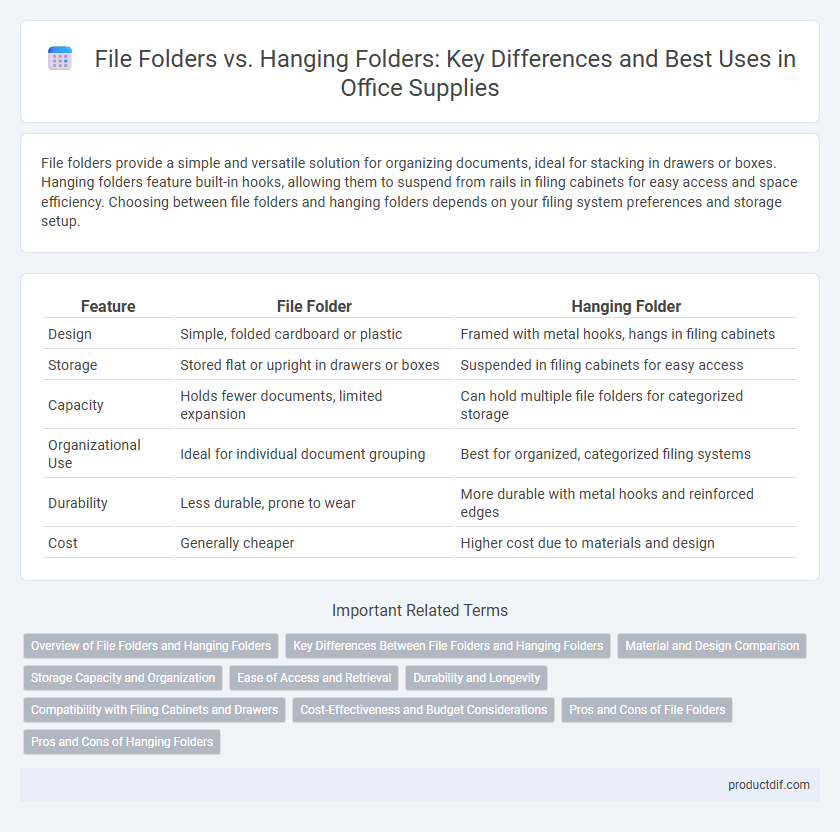File folders provide a simple and versatile solution for organizing documents, ideal for stacking in drawers or boxes. Hanging folders feature built-in hooks, allowing them to suspend from rails in filing cabinets for easy access and space efficiency. Choosing between file folders and hanging folders depends on your filing system preferences and storage setup.
Table of Comparison
| Feature | File Folder | Hanging Folder |
|---|---|---|
| Design | Simple, folded cardboard or plastic | Framed with metal hooks, hangs in filing cabinets |
| Storage | Stored flat or upright in drawers or boxes | Suspended in filing cabinets for easy access |
| Capacity | Holds fewer documents, limited expansion | Can hold multiple file folders for categorized storage |
| Organizational Use | Ideal for individual document grouping | Best for organized, categorized filing systems |
| Durability | Less durable, prone to wear | More durable with metal hooks and reinforced edges |
| Cost | Generally cheaper | Higher cost due to materials and design |
Overview of File Folders and Hanging Folders
File folders are flexible, lightweight paper or plastic organizers designed to hold and group loose documents for easy access and portability. Hanging folders feature rigid frames with hooks that suspend inside filing cabinets, providing structured support and separating contents for improved organization. Both types optimize office storage, with file folders ideal for short-term handling and hanging folders suited for long-term filing systems.
Key Differences Between File Folders and Hanging Folders
File folders are simple, foldable paper or plastic holders designed to organize documents individually, while hanging folders feature metal hooks that hang on rails inside filing cabinets for easy access and stability. File folders are best for temporary or portable use, whereas hanging folders provide more structured organization within filing systems. The key difference lies in their function: file folders hold papers together, and hanging folders support those file folders in a suspended system.
Material and Design Comparison
File folders are typically made from sturdy cardstock or plastic, offering durability and flexibility for storing individual documents, while hanging folders feature metal hooks attached to a reinforced plastic or heavy-duty cardboard frame designed to suspend from filing cabinet rails. The design of file folders emphasizes portability and ease of access, whereas hanging folders prioritize organized storage and space efficiency within filing systems. Material choice impacts longevity and usability; plastic hanging folders resist moisture better than cardstock file folders, which can wear or tear more quickly under frequent handling.
Storage Capacity and Organization
File folders typically offer greater storage capacity for individual documents, allowing bulkier stacks to be securely contained. Hanging folders excel in organization by suspending files within a filing cabinet, enabling easy access and separation of categories with labeled tabs. Combining both enhances overall filing efficiency through maximized storage and streamlined document retrieval.
Ease of Access and Retrieval
File folders provide quick, direct access by allowing individual documents to be easily removed and replaced, ideal for frequently referenced papers. Hanging folders enhance organization within filing cabinets by suspending file folders for smoother sliding and better visibility, reducing retrieval time in bulk storage. Combining both types optimizes ease of access and simplifies document management in office environments.
Durability and Longevity
Hanging folders typically feature metal hooks and reinforced edges, providing superior durability and extended longevity compared to standard file folders made from lightweight paper or thin cardboard. File folders may wear out faster with frequent handling, while hanging folders maintain structure and protect documents over long-term use. Choosing hanging folders ensures a more robust solution for heavy-duty filing systems requiring sustained durability.
Compatibility with Filing Cabinets and Drawers
File folders are designed to fit snugly within drawers and standard filing cabinets, offering easy stacking and straightforward organization without additional accessories. Hanging folders feature built-in hooks that suspend from rails inside filing cabinets or drawers, ensuring stability and quick access while preventing slipping or stacking issues. Compatibility depends on the filing system: file folders suit open flat storage, whereas hanging folders require compatible rails in filing cabinets or drawers for optimal functionality.
Cost-Effectiveness and Budget Considerations
File folders generally offer a lower upfront cost compared to hanging folders, making them suitable for tight office budgets and smaller storage needs. Hanging folders, while slightly more expensive, provide greater durability and organization efficiency by securely holding multiple file folders in cabinets, reducing the frequency of replacements. Businesses aiming for long-term cost-effectiveness often invest in hanging folders to minimize maintenance and improve workflow despite higher initial expenses.
Pros and Cons of File Folders
File folders offer easy access and versatile organization, making them ideal for categorizing documents by project or client. They are lightweight and cost-effective but lack the suspension system of hanging folders, which can lead to less efficient use of vertical filing space. File folders may also be prone to bending or tearing, reducing durability compared to hanging folders designed for extended storage.
Pros and Cons of Hanging Folders
Hanging folders offer easy access and enhanced organization by suspending files within filing cabinets, reducing clutter and improving document visibility. They are designed to hold multiple file folders securely, which prevents papers from shifting or falling out, making them ideal for large filing systems. However, hanging folders require compatible filing cabinets and can be less portable than standard file folders, limiting flexibility in mobile office setups.
File Folder vs Hanging Folder Infographic

 productdif.com
productdif.com